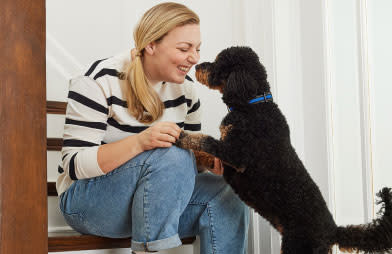Calculating healthy portions
Determining how many calories a dog or cat needs in a day requires some math. Life stage, size, breed, and activity level are all factors to consider. Most pet food makers offer rough feeding guidelines on their packages but consulting with your vet can provide you with more specialized guidance.
Once you’ve determined how many calories they need in a day, you can then figure out how much food to put in their bowl … just remember to also consider the amount of calories that come from treats (and that no more than 10% of total daily calories should be derived from treats).
The majority of pets will happily overeat but what do you do if you’re contending with a picky eater? Nutritionist Kylie Hogan recommends a little bit of tough love. And if all else fails, bribery.
“Most of the time they're not going to starve themselves,” explains Hogan. “They have survival instincts so they'll eat when they need to. Some pets — whether they're anxious or not naturally food-driven — don't really care about food as much.”
However, she adds, “if it's a deeper issue than finding food that they like, there are so many tricks for helping a pet to eat: breaking up some treats, adding water or pet broth, or adding some wet food to the kibble [can] make food more enticing.”
Sometimes the stinkier the food topper, the better!
The benefits of rotational feeding
Rotational feeding is another strategy to keep your pet interested at mealtimes, but it also offers health benefits too. “I think you should be switching your food at least once a year,” says Hogan. “I wouldn't change more than every three to four months, because that might be a little bit too much for them [but] you should be feeding two different foods a year.”
Food can be rotated seasonally, as your pet’s outdoor time or activity level increases or decreases. In fact, food rotation is one of Hogan’s top tips for healthy feeding.
“It's really important that you introduce pets to as much as possible because, similar to kids, if you don't give your kid peanut butter at a young age, they can develop a peanut butter allergy when they're older. It’s the same thing. Switching the proteins up is good and it's really beneficial in regards to the seasons as well,” she says.
“In the winter, you might go for fewer walks because it's colder out so you might want to feed something that's a little lighter in calories and lighter in fat. Or it's a little bit drier out and your pet might have skin and coat issues so you might want to switch to a fish diet or a sensitive skin and stomach diet,” Hogan explains.
A fish-based diet not only nourishes the skin because of natural fish oils, but can be a good hypoallergenic option.
“And then in the summer, they might be more active and you might want to feed them a more robust diet, like beef or lamb or something that has multiple proteins in it,” says Hogan.
For pets with dietary sensitivities, it’s still possible to introduce a range of proteins and ingredients into their diets so they benefit from those nutrients, while keeping their base diet constant. “Even if you just buy fun things to throw on top all the time, and they're different proteins, that's still great because it introduces them to more ingredients,” says Hogan.
But of course, be cautious not to give them an ingredient that causes a negative reaction.

















































